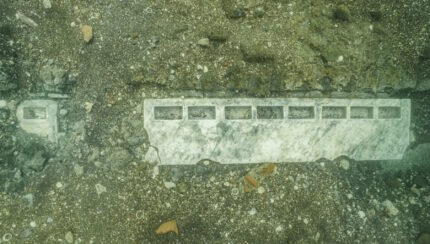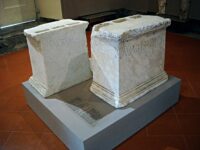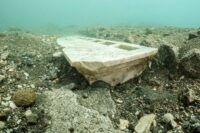The remains of two altars from a Nabatean temple have been discovered on the seabed of Pozzuoli in southern Italy, the now-submerged heart of the ancient commercial port of Puteoli. The altars date to the first half of the 1st century A.D. and are similar to the larger, more complete great altar discovered in the same area by fishermen in 1965. The base of that altar bears the inscription DVSARI SACRVM, or “sacred to Dusares,” (aka Dushara) the head deity of the Nabatean pantheon and unique to the Nabatean religion.
The slots in the top of the altar slabs are votive niches that originally held betyls, sacred stones venerated as effigies of the gods. Traditional Nabatean religion was aniconic, meaning there were no figural representations of the gods. Instead, the gods were represented by cultic stelae/standing stones. A later colossal bust of Dushara was discovered in Pozzuoli and is now in the Vatican Museums. By this time his image had become fully Romano-Hellenized, so he was fully figural. As the head of the Nabatean pantheon, he was identified with Zeus and depicted as a man with a thick curly beard.
 These finds bring the total number of Nabatean altar slabs and altar bases found in this area of sunken city to five since the first was discovered in the 18th century. (The first three — two bases and one slab — are now in the collections of the National Archaeological Museum of Naples and the Archaeological Park of Campi Flegrei at the Castle of Baiae.)
These finds bring the total number of Nabatean altar slabs and altar bases found in this area of sunken city to five since the first was discovered in the 18th century. (The first three — two bases and one slab — are now in the collections of the National Archaeological Museum of Naples and the Archaeological Park of Campi Flegrei at the Castle of Baiae.)
Founded as a Greek colony in 531 B.C., Puteoli was made a Roman colony in 195 B.C. and became Rome’s principal port at the center of the Mediterranean traffic in goods — wine, Tyrian purple, textiles, perfumes, jewels, etc — from and to Europe, the Levant and the Near East. Between the 1st century B.C. and the 1st century A.D., the merchants of Puteoli spread out far and wide in the Mediterranean world, establishing trade relations with local populations and securing lucrative contracts. The foreign producers and traders who traveled to Puteoli eventually formed permanent communities there with their own homes, shops, temples and cemeteries.
 The Nabateans, an Arab people whose territory at its apex in the 1st century B.C. stretched from the Euphrates to the Red Sea, controlled trade routes conveying luxury goods from the Indian Ocean and the Far East to the Arabian peninsula and southern Levant. The magnificent rock-cut capital of Petra in modern-day Jordan was the last stop of caravans on the lucrative spice and perfume routes before the goods were shipped overseas to Europe from the Port of Gaza. The kingdom became a vassal state of Rome in the 1st century B.C., albeit still very much independent, and was absorbed into the Roman empire by Trajan in 106 A.D.
The Nabateans, an Arab people whose territory at its apex in the 1st century B.C. stretched from the Euphrates to the Red Sea, controlled trade routes conveying luxury goods from the Indian Ocean and the Far East to the Arabian peninsula and southern Levant. The magnificent rock-cut capital of Petra in modern-day Jordan was the last stop of caravans on the lucrative spice and perfume routes before the goods were shipped overseas to Europe from the Port of Gaza. The kingdom became a vassal state of Rome in the 1st century B.C., albeit still very much independent, and was absorbed into the Roman empire by Trajan in 106 A.D.
Their trade interests put the Nabateans in business with Puteoli, which by the 1st century was the largest commercial port on the Mediterranean. The Nabatean community settled in the Vicus Lartidianus, the suburban neighborhood on the southern edge of Puteoli where the foreign merchants lived and transacted their business.
While the presence of the Nabatean temple was known from the discovery of the altars, its exact location, position and dimensions were not. The recent discovery of the altars and a new topographical survey have allowed researchers to pinpoint the precise position of the temple, as well as warehouses, imperial administration buildings and roads of the ancient port.
There is some discussion among experts that speculates on whether the Ka’baa now venerated by Islam has its roots in these monolithic monuments
Did Trier fall into the sea due to an earthquake, slowly wash into the sea, or something else? Or perhaps the altars were disposed of as the religion changed? Do we know? Thanks!
@Jim – I can rule totally out that “Trier” fell “into the sea” 😀
In fact, Trier is discussed in the other post. Here, we are in central Italy. Indeed, “seismologic activities” -i.e. earthquakes and all– seem to have been a factor. The “Phlegraean Fields” feature bradyseismic phenomena, the slow gradual uplift (positive bradyseism) or descent (negative bradyseism) of part of the Earth’s surface, caused by the filling or emptying of an underground magma chamber or hydrothermal activity.
A different matter is e.g. Domburg on the northwest coast of Walcheren in the Dutch province of Zeeland, where in 1647 after heavy storms, a sanctuary was discovered with Latin inscriptions and carvings of several gods: Neptune and Mercury (trade), and particularly Nehalennia, a local female deity, who appears to have protected trade and shipping.
Descriptions of Phoenician traders that sailed around Africa –already in the first millennium BC– can be found in Herodotus’ histories, and my favourite is Pliny writing about “Indos a rege Sueborum dono datos, qui ex India commercii causa navigantes tempestatibus essent in Germaniam abrepti”, i.e. “Indians” handed over to Quintus Metellus Celer by the Suebi, after they had been washed ashore in a storm, where they originally had wanted to trade.
Mediterranean oil and wine jars at a place called “Tintagel” indicate an extensive trade in Sub-Roman Britain with the Mediterranean region:
While ‘tin’ is certainly an Anglo-Saxon term, the “Tin islands” were referred to as Κασσιτερίδες in antiquity (“Cassiterides”), cf. Herodotus. A crucible/ pan, on the other hand, would be a τάγηνον (“tagenon”).
My bad, I meant Puteoli, not Trier. Didn’t have my first cup of coffee yet 😉
I’m a big fan of Pliny but not much of a scholar. I know a little bit about his familiarity with the Red Sea. Somewhere he references Red Sea dugongs (sea cows). I can’t remember if he mentioned hides or just what. Do you know this one?
Thanks!
I would need to look that up. His ‘Naturalis Historia’ comes in 37 books with 2493 chapters, of which in books 8-11 zoologic issues are discussed, here apparently in bk. 9 with 650 entries on marine animals. He remains skeptic:
“although Dinon, the father of Clearchus, a celebrated writer, asserts that they (“sirenia”) exist in India, and that they charm men by their song, and, having first lulled them to sleep, tear them to pieces.”
Not totally unlike today, ancient authors would have a chat with would-be experts (e.g. traders), would have read, what others had written, would visit places and watch for themselves, and -maybe- would come up with some kind of conclusion.
In Herodotus it reads like the Persian Gulf, however, the “Red Sea” (in Greek ‘Erythros’=Red) was back then a little more than what it is today, i.e. the Indian ocean to India and beyond:
The “Periplus of the Erythraean Sea” (“Περίπλους τῆς Ἐρυθρᾶς Θαλάσσης”) describes navigation and trading opportunities from Roman Egyptian ports along the coast of the Red Sea, then others along the Horn of Africa, the Persian Gulf, Arabian Sea and the Indian Ocean, including the modern-day Sindh region of Pakistan and southwestern regions of India.
Thanks for the reference, that’s a good one. I’m a marine biologist and sirenian specialist (we write status reviews and conservation plans for the remaining sea cows) and the dugongs in the Middle East are of interest. Historical fisheries for dugongs in the region are poorly described but extant, there is a purported religious structure with a focus on dugongs (in the Emirates, if I’m not mistaken), and then the mummified mermaids of Aden (a horrific tourist display of dugongs posed to resemble mermaids from the late 1800s/early 1900s). I’m sure that there’s additional material out there, just not familiar with it. Thanks again!
My regards to the “real” sirenia, and of course their saviours!
At closer inspection, it is BOOK.10(!), actually:
———
“… I think the Pegasus, the horse-headed birds and the griffins with their beaks hooked in gold, are a legend, those in Scythia, these in Ethiopia. However, the Tragopan(a), is confirmed by many, a greater eagle, having curved horns in times, of a rusty color, but with a Phoenix head.” …
[our part] “…nec Sirenes impetraverint fidem, adfirmet licet Dinon, Clitarchi celebrati auctoris pater, in India esse mulcerique earum cantu quos gravatos somno lacerent. …”
“…likewise, it is hard to believe that Siren(s/ia) do exist, although Dinon, the father of Clearchus, a celebrated writer, asserts that they can be found in India, and that they charm men by their song, and, having first lulled them to sleep, tear them to pieces. …” [Beware!]
———
PS:
As I kid, I had a stopover in Dubai on my way to Kalimantan/ Borneo, Indonesia, where I spent time in the jungle, on the Mahakam river, and, at sea and below (rather) close nearby. At one occasion, when they heard that I was from Germany, I was disturbingly welcome with “Heil Hitler” –in the 1980ies!– by either the village idiot or burgomaster.
Particularly, I could hear stories of the Irrawaddy dolphin, a.k.a. “Pesut Mahakam”, but unfortunately did not see any of them. The area is close to where the Indonesians plan to erect their new capital (as their old capital Batavia/ Jakarta –according to some– is about to fall into the sea). Not entirely good news for those dolphins, I am afraid.
Occasionally, small planes have disappeared. Another “highlight”, therefore, were the standard flight preparations for the trips by plane into the jungle, where our two pilots –in their local language– ALWAYS, highly agitated and with pocket calculator at hand, were shouting at each other, almost at each others’ throats 😀